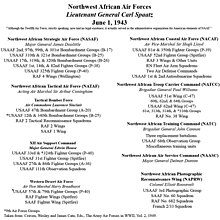Northwest African Air Forces
| Northwest African Air Forces (NWAAF, NAAF) | |
|---|---|
Brigadier General Laurence S. Kuter (right). | |
| Active | Formed February 18, 1943.[1] |
| Allegiance | Allies of World War II |
| Branch | United States Army Air Forces/Royal Air Force/South African Air Force/Royal Australian Air Force |
| Type | Major Command |
| Role | "Open the Mediterranean sea lanes and help drive the Axis from Tunisia and Africa" (David R. Mets)[2] |
| Engagements | 1943-02-18 North African campaign 1943-02-18 Tunisia Campaign[3] 1943-06-25/26 Oil campaign of World War II (Bari, Italy) |
Northwest African Air Forces (NAAF) was a component of the
The first units of the
NAAF was organized on a successful tripartite (or "tri-force")
Structure
From February 18, 1943, the Northwest African Air Forces (NAAF) under Lieutenant General
- B-17 Flying Fortresses, No. 205 (Heavy Bomber) Group's bombardment force consisting of four wings (10–12 British Commonwealth bomber squadrons)[6] and several heavy bomber elements from the USAAF Ninth Air Force;[7]
- Northwest African Coastal Air Force (NACAF), initially under (acting commander) Group Captain G. G. Barrett and, soon afterwards, Air Vice-Marshal Hugh Lloyd: comprised No. 201 (Naval Co-operation) Group's anti-shipping coastal force (10 squadrons: Greek, Royal Australian Air Force (RAAF), South African Air Force (SAAF) and Royal Air Force (RAF); and
- 12th BombardmentGroups) and XII Air Support Command units.
The following support commands were also assigned to NAAF:
- Northwest African Air Service Command (NAASC) under Major General Delmar H. Dunton;
- Northwest African Training Command (NATC) under Brigadier General John K. Cannon;
- Northwest African Photographic Reconnaissance Wing (NAPRW) under Colonel Elliott Roosevelt, the US president's son; and
- Paul L. Williams.
Operations
To foster cooperation between the British RAF and the American USAAF in particular, the commands listed above and their various sub-commands were intended to have a commanding officer from one air force and a deputy from the other air force. In keeping with this plan, Spaatz's deputy of NAAF was Air Vice-Marshal James Robb who handled operations.[4][5]
Strong consideration was also given to the concept that air, naval, and ground forces should coordinate effectively to provide optimum support of ground troops. In 1942–1943, when the role of air power was still being explored on the battlefield, classic close air support was essentially pioneered and developed by Tedder as Commander-in-Chief of Middle East Command and Coningham as Air Officer Commanding (AOC) of Air Headquarters Western Desert.
The importance of flexible coordination between air, naval, and ground forces took much time to realize let alone implement during the Desert war. Finally, it was Tedder (Churchill's second choice for Middle East Commander when Air Vice-Marshal Owen Boyd was captured) who finally realized, despite the encumbrances of the current military dogma and commander egos, that every campaign must be planned and executed as a "joint operation" by all three forces. Soon after being named Air Officer Commanding of RAF Middle East in June 1941, Tedder said: "In my opinion, sea, land and air operations in the Middle East Theater are now so closely inter-related that effective coordination will only be possible if the campaign is considered and controlled as a combined operation in the full sense of that term."[8] In particular, the flexibility between Coningham's WDAF and the 8th Army has been contrasted with the more rigid relationship between the Luftwaffe and German ground forces.[9]


The United States
NAAF was the first official command based upon the "tri-force" model. Successfully practiced and developed during the
Termination & reorganization of NAAF
On December 10, 1943, MAC was disbanded and the Allied air forces in the MTO were again reorganized as the
- Mediterranean Allied Strategic Air Force (MASAF) under Major General Nathan Twining;
- Mediterranean Allied Coastal Air Force (MACAF) under Air Vice-Marshal Hugh Lloyd; and
- Mediterranean Allied Tactical Air Force (MATAF) under Major General John K. Cannon.
Notes
- ^ Arnold, Henry A., AAF: The Official Guide to the Army Air Forces, Special Edition for AAF Organizations, Pocket Books, New York, (1944), p. 152
- ^ Mets, David R., Master of Airpower: General Carl A. Spaatz, Presidio Press, Novato, CA (1988) p. 156.
- ^ Arnold, Henry A., AAF: The Official Guide to the Army Air Forces, Special Edition for AAF Organizations, Pocket Books, New York, (1944), p. 25
- ^ ISBN 0-912799-03-X).
- ^ a b Richards, D. and H. Saunders, The Royal Air Force 1939-1945 (Volume 2, HMSO, 1953).
- ^ "Organisation and Equipment of No 205 Group". Guernsey.net. 1944-05-10. Archived from the original on 2012-02-25. Retrieved 2012-03-26.
- ^ Craven and Cate, Volume 2 (1949):p. 18.
- ^ Dick, Ron and Dan Patterson, Aviation Century, World War II, Boston Mills Press, 2004, p. 71.
- ISBN 0-7006-1081-2.
References
- Craven, Wesley F. and James L. Cate. The Army Air Forces in World War II, Volume 2, Chicago, Illinois: Chicago University Press, 1949 (Reprinted 1983, ISBN 0-912799-03-X).
- Richards, D. and H. Saunders, The Royal Air Force 1939-1945 (Volume 2, HMSO, 1953).
- Howe, George F., Northwest Africa: Seizing the Initiative in the West, Center of Military History, Washington, DC., 1991.
